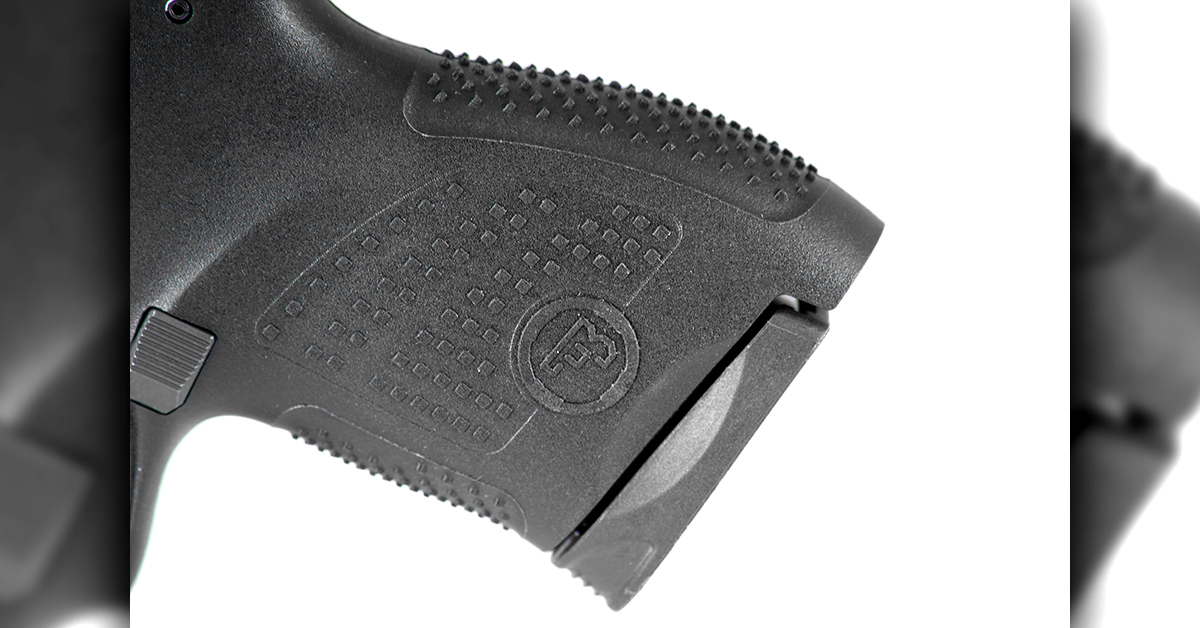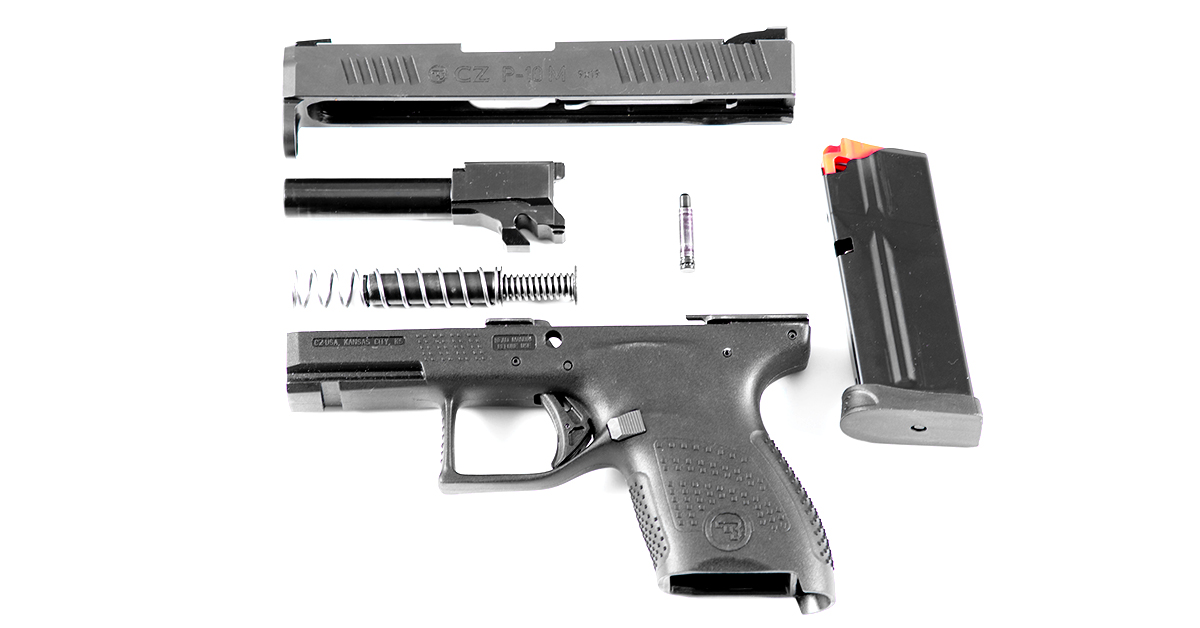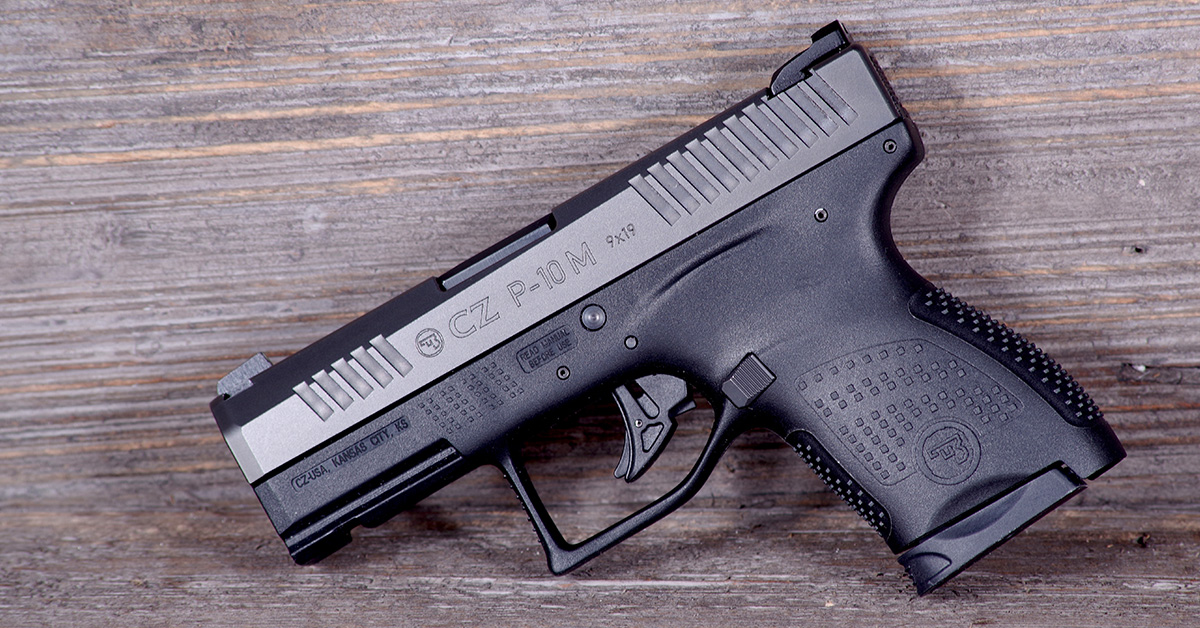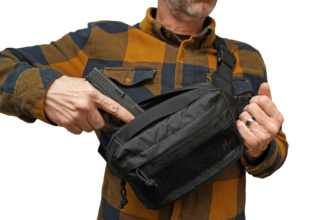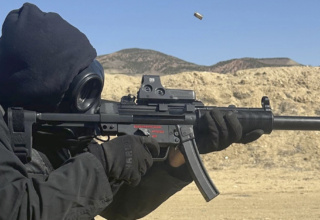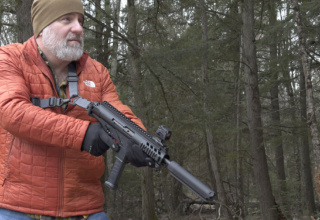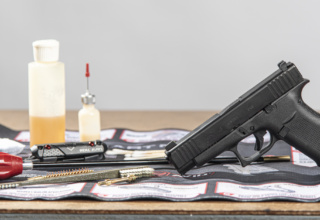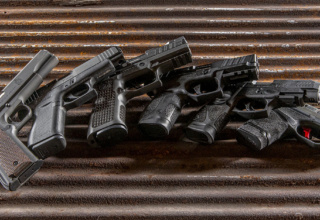CZ hits the market with a snag-resistant micro-compact
by Robb Manning
When a new gun model hits the market, the first things I look at are the intended purpose of the gun and what sets it apart from other guns with a similar purpose. Concealed carry is one of the largest segments driving the firearms market, and it has been for many years. In the case of the micro-compact CZ P-10 M, it enters a very crowded marketplace.
What sets the P-10 M apart from the crowd is the smooth slide. It is designed to be snag resistant — there is no external slide stop lever and no thumb safety. The only thing that protrudes is the magazine catch, but that is low-profile with rounded edges.
The P-10 M is semi-auto striker-fired handgun with a fiber-reinforced frame. It fires from a locked breech, incorporating the Browning tilted-barrel design, with a short recoil operating system. It has a partially pre-cocked DA trigger mechanism, which means that before firing, the striker rests in a partially cocked position. As the shooter pulls the trigger, the striker continues to move until it is fully cocked, and then it releases.
CZ’s P-10 line includes the P-10 F (full-sized), P-10 C (compact), P-10 S (sub-compact), and P-10 M (micro-compact). It’s a logical naming convention that’s simple to figure out.
Most of the P-10 line incorporate three safeties — trigger safety, drop safety, and what CZ calls the “automatic safety” (firing pin block) — except for the P-10 M, which does not have the automatic safety.
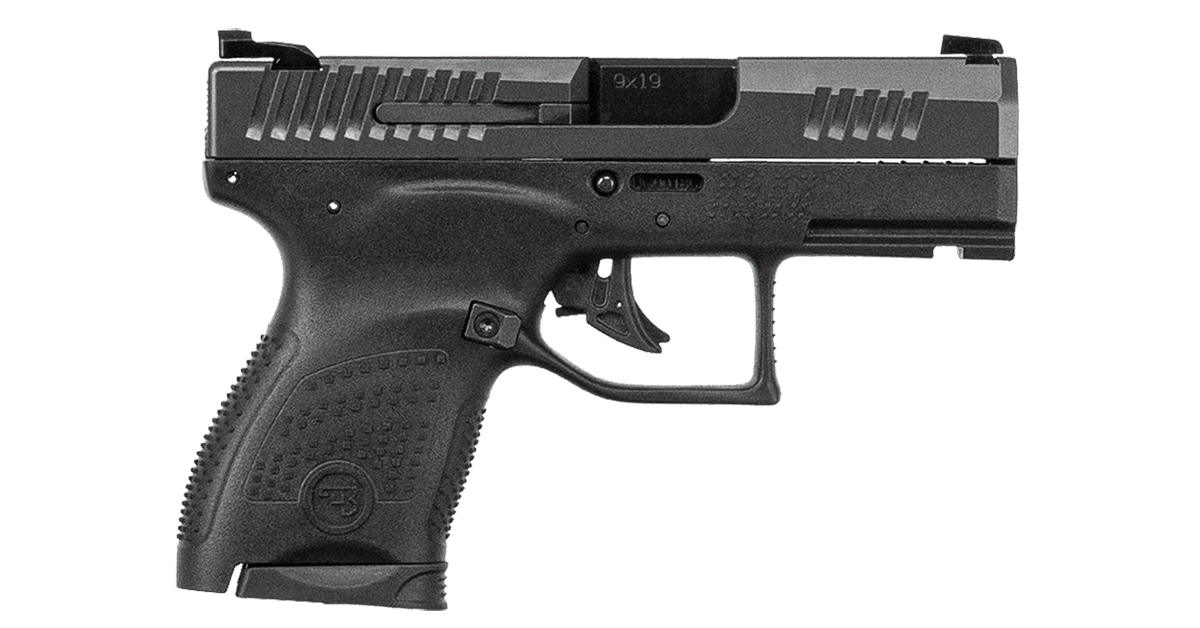
The gun comes with steel front and rear sights. The rear sight is adjustable for windage by loosening the set screw and drifting the sight in the dovetail and then securing the screw. To adjust elevation, the front sight can be swapped out for a shorter or taller one (not included). The set screw makes it easy to swap.
I own many CZ firearms, including military surplus, historic, and rare, but it’s been a couple of years since I’ve purchased my last CZ — a P-10 C, and one of the constants with all of them is they all say “Made in Czech Republic” or “Made in Czechoslovakia” and have import marks. Not this P-10 M. It has neither because the P-10 M is made in the USA. Kansas City to be exact.
Controls
Getting back to the controls, some people will like the snag-free design and some people won’t. It is a little outside of the box from the rest of the carry market, and I give CZ kudos for that. There are three controls on the side of a handgun that can potentially snag: manual thumb safety, magazine catch, and slide stop. Here’s how CZ approached them:
Manual thumb safety – Lack of a manual thumb safety is common for modern striker-fired handguns. Most are offered without a thumb safety, a few offer a choice.
Magazine catch – It is low profile, but still accessible by thumb without rotating the handgun in the hand. It is not ambidextrous but is swappable for left-hand shooters.
Slide stop – The lack of an external slide stop lever is the primary feature of the M that sets it apart from other handguns, and the decision-maker for if a person purchases this gun or doesn’t. To be clear, it does have a slide stop; if an empty magazine is inserted, the slide can be locked to the rear or, if a full magazine is emptied through the act of firing, the slide will lock to the rear after the last round is fired. But there is no slide stop lever, which means the slide cannot be locked to the rear manually unless an empty magazine is inserted.
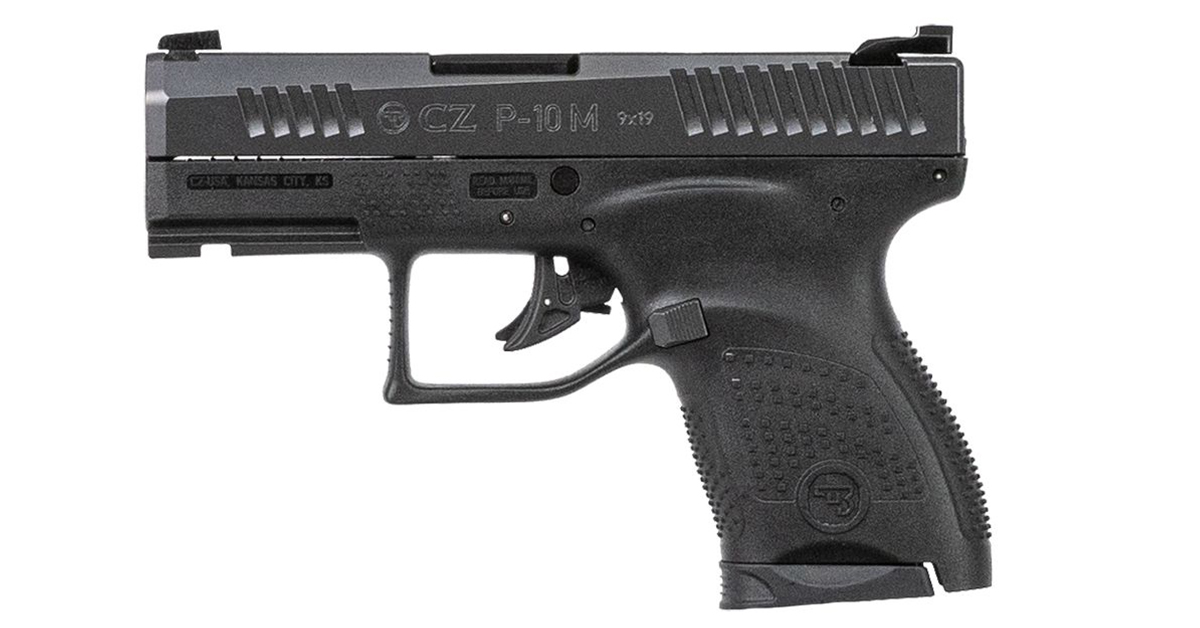
There are pros and cons to the lack of an external slide stop lever. The pros:
– The obvious, there is one less thing to get snagged on something during draw.
– There is no slide stop lever to accidentally thumb while shooting, causing an inadvertent stoppage.
– It forces the user to load the handgun by manipulating the slide, not pressing the magazine stop to send the slide forward. This is the preferred method regardless of whether a handgun has a magazine stop or not.
The con:
– The slide cannot be locked to the rear manually. To do so requires an empty magazine be inserted into the magazine well.
All this means that most shooters will almost always need an empty magazine present because: (a) most ranges require the slide to be locked to the rear anytime the handgun is set down on a table or bench; and (b) for performing a safety check, it is best to lock the slide to the rear when doing the visual and physical inspection.
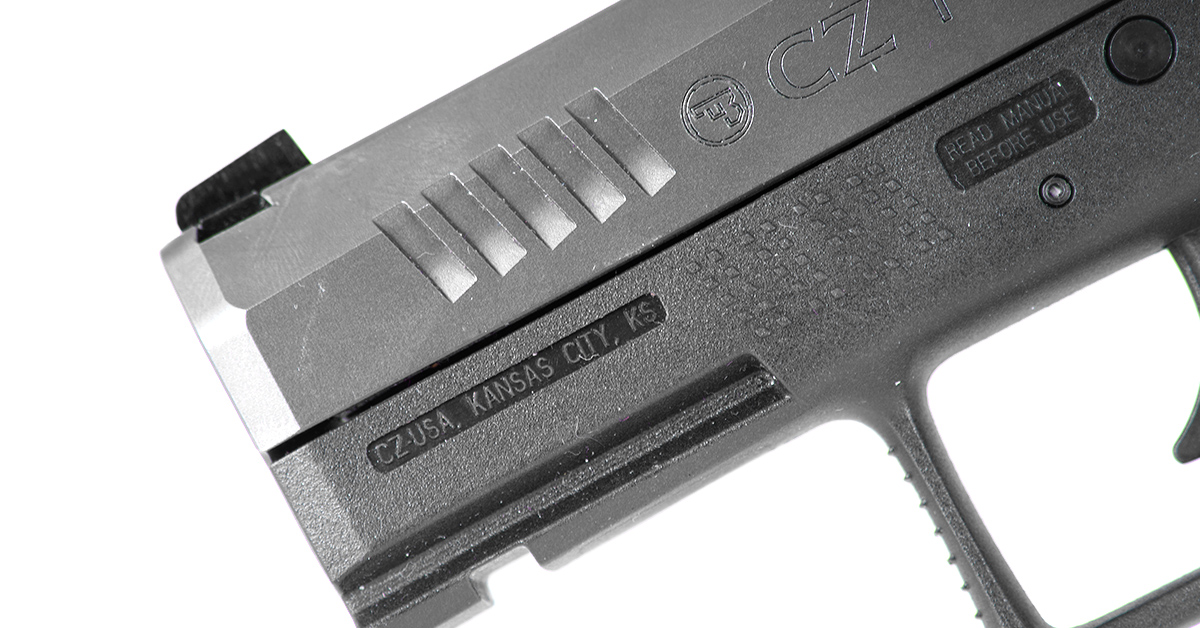
Many moons ago, I had a first-generation Walther PPS, and that didn’t have an external slide stop lever on it. In fact, it was my carry gun for a while. Through regular training with it, I got accustomed to pulling back on the slide to chamber a round instead of using the slide stop lever to release the slide. But I admit, needing an empty magazine to lock the slide to the rear was a hassle. You won’t realize how often you want/need to lock the slide to the rear until you don’t have a manual lever to do it.
With that said, the “con” is just merely a hassle. But the “pro” to not having a slide stop lever is all operational and has far more serious implications. Having your gun snag on something when you draw it in a self-defense situation can be catastrophic. Having your thumb inadvertently press the slide catch and lock the slide back when you are shooting in self-defense situation can also be catastrophic (and even more likely with winter gloves). The “pros” far outweigh the “con.”
For those who use the slide stop to chamber a round, no worries. Changing habits is a matter of training. I believe you can train your way out of just about anything. To start, you don’t even need to go to the range. You can practice mag loads and reloads using dry fire. All you need is a dummy round to simulate chambering a round.
Get A Grip
The P-10 M’s grip is well-textured, providing a secure grip even for those with large hands. The front and back straps are aggressive, which is where it’s needed most, but the side panels aren’t, so grip-to-skin contact while carrying IWB will be fine. Grip texture is all about personal preference, and I like what CZ did with the texturing for the P-10 M. I fired it with bare hands, with light-weight gloves, and with thick winter gloves, and the grip provided excellent purchase with no slippage in all three hand/glove conditions.
Speaking of gloves, one thing as a northerner that I’ve always appreciated about CZ firearms is the oversized trigger guard to accommodate a winter-gloved hand. The Czech Republic gets cold, so they get it. I’m a bit disappointed that the P-10 M doesn’t accommodate a winter glove very well, and it’s not for a lack of real estate. The trigger guard is the same size as the P-10 C, and that one works fine with a winter glove.
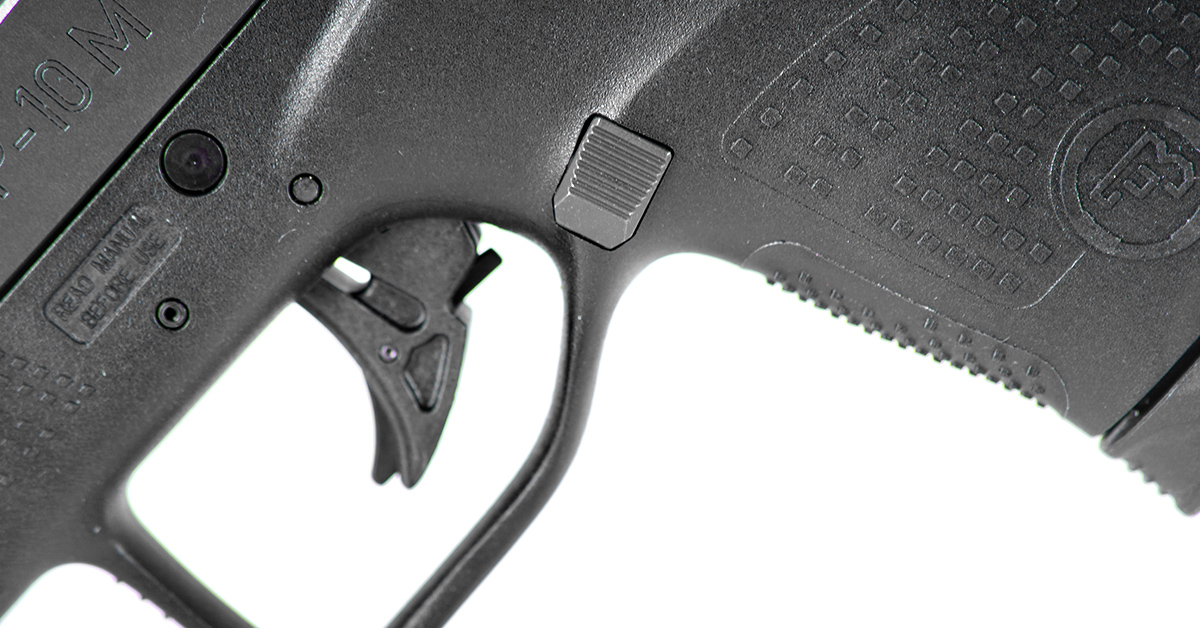
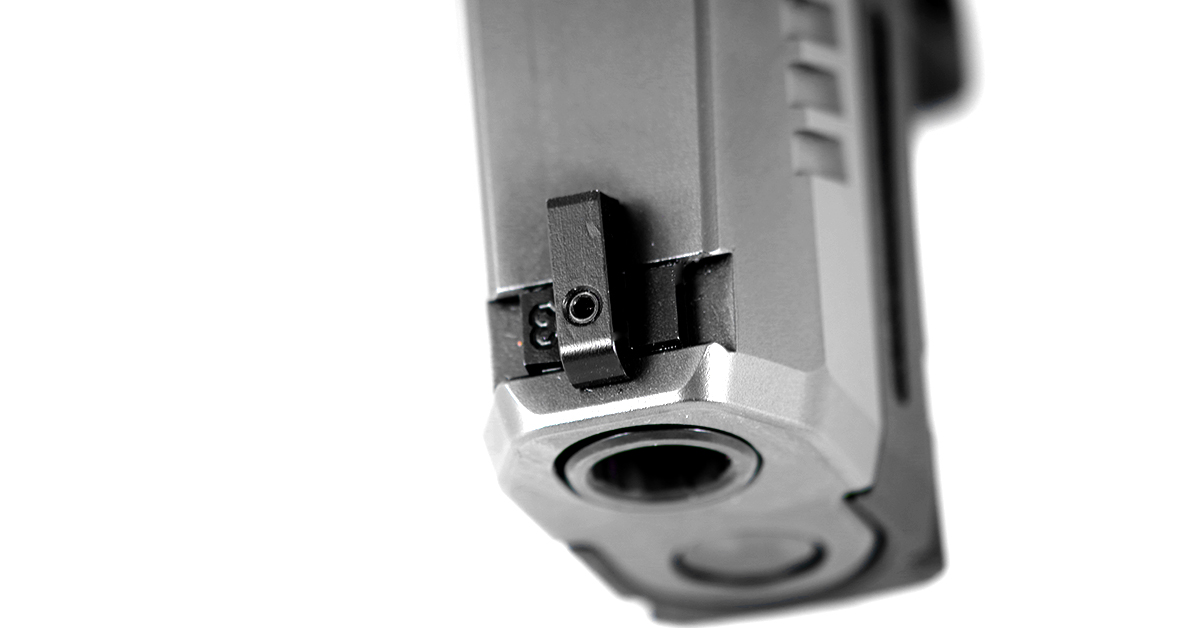
There are two design questions I have regarding snag-free draw, and both are minor. The first thing is the accessory rail. For a snag-free design, it wouldn’t be advisable to mount accessories on the handgun. Not to mention that accessories add size, which defeats the purpose of a micro-compact handgun. So why even have it? The rail, left empty, probably isn’t a major snag hazard, but could cause drag during the draw, especially with a leather holster. The second thing is the front slide serrations. Again, it’s not that these are a major snag hazard, but they could cause drag during the draw.
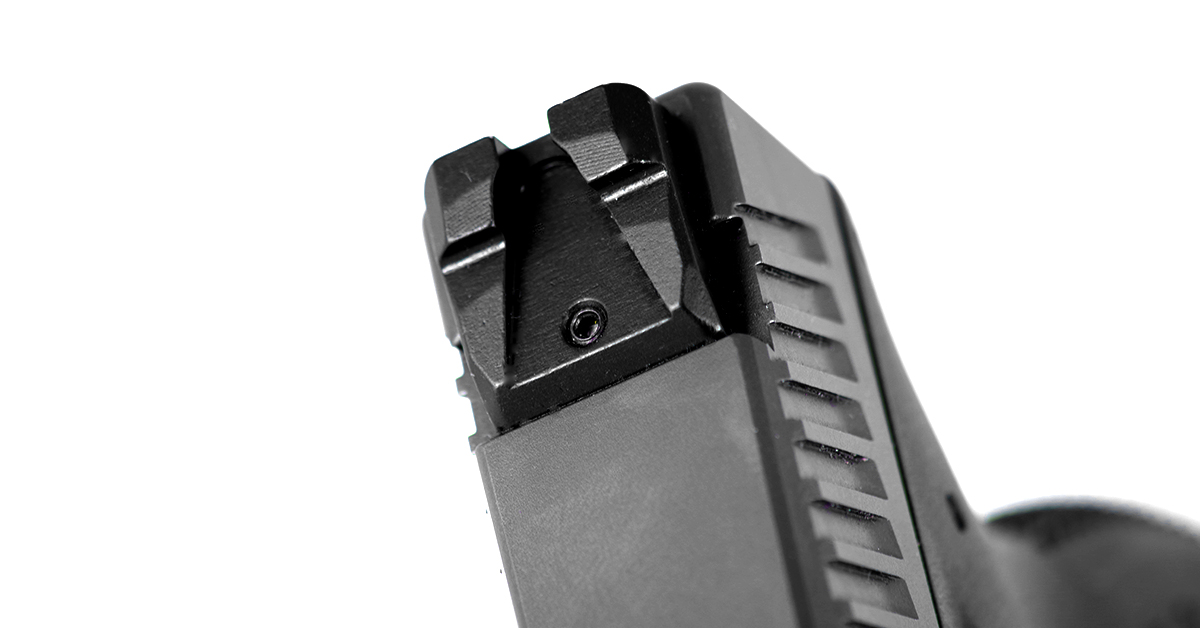
Testing
The P-10 M performed well, as I expected it would. Accuracy was determined with 5-shot groups, but due to ammunition restraints, I fired only two strings of fire for each load. Another huge factor, I’m not going to lie, it was a nippy 2 degrees F that morning. About 3/4 of the way through testing, the numbness in my fingertips was gone, leaving me more focused on the burning sensation that replaced it than on making accurate shots.
The test pistol loved the Wolf Performance Ammo (WPA) 115-grain FMJ, which was the two best groups of the day at about 1.5-inch groups. I was surprised this ammo did as well as it did, as I’ve had it stored in less-than-optimal conditions in my garage for about 20 years now. It also liked the Federal Premium HST 124-grain JHP, which averaged just under two inches for the two groups. The Norma 108 grain MHP (Monolithic Hollow Point) didn’t fair as well, averaging 3.1 inches for the two groups. I have no prior experience with this load, so I don’t have a baseline for how it does in other handguns. It was the first 9mm ammo to start trickling back onto the store shelves in my area, so I picked some up.
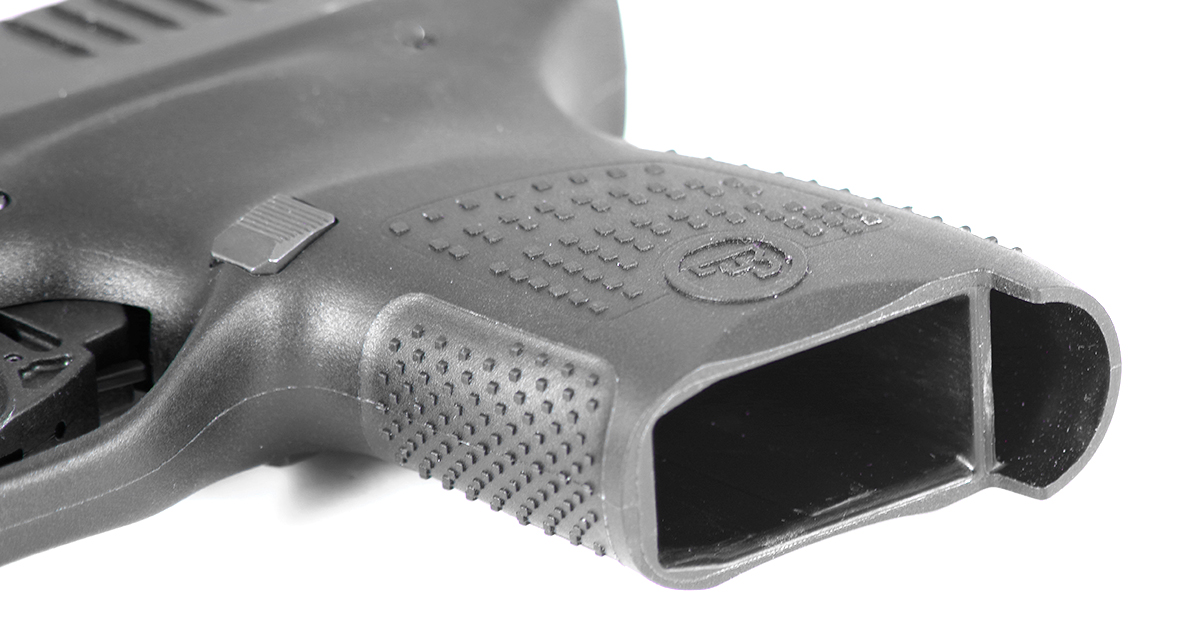
Performance Data
Ammo / Avg. Velocity / Ext. Spr. / Std. Dev. / Accuracy (1st grp, 2nd grp)
- WPA Polyformance 115 gr.: 1058.34 fps, 76.62 fps, 37.46 fps, 1.47 in., 1.54 in.
- SIG 365 Elite Perf. FMJ 115 gr.: 1110.14 fps, 62 fps, 24.72 fps, 2.55 in., 89 in.
- Black Hills FMJ 115 gr.: 1112.83 fps, 38.71 fps, 14.28 fps, 2.92 in., 2.62 in.
- Federal HST JHP 124 gr.: 1125.12 fps, 58.37 fps, 22.81 fps, 1.93 in., 2.02 in.
- Norma MHP 108 gr.: 1207.81 fps, 57.3 fps, 21.10 fps, 3.29 in., 2.94 in.
Velocity is average of five shots. Accuracy is two strings of five shots at 12 yards. Ext Spr = Extreme Spread, Std Dev = Standard Deviation.
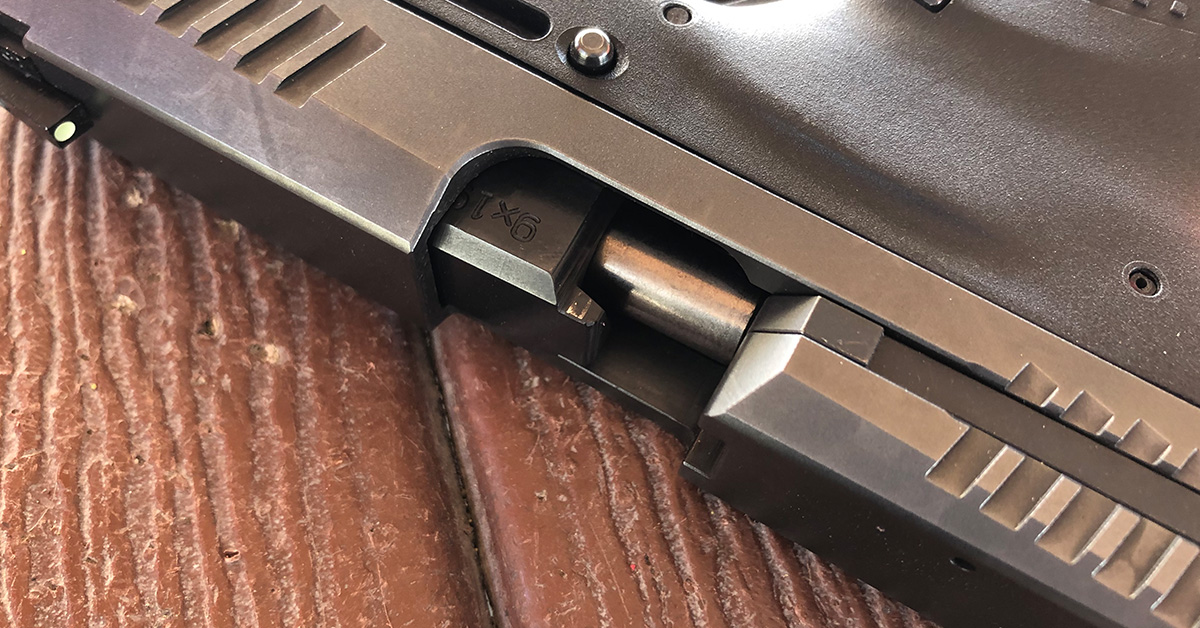
The only malfunctions of the day were from the Norma ammo, with three stoppages. All three were the same stoppage: the fired round extracted and ejected fine, then the next round started to enter the chamber but got hung up. So, the slide never went into battery. I’m not sure what the problem was because this load was fired under the same conditions as the other loads, which did not have any problems.
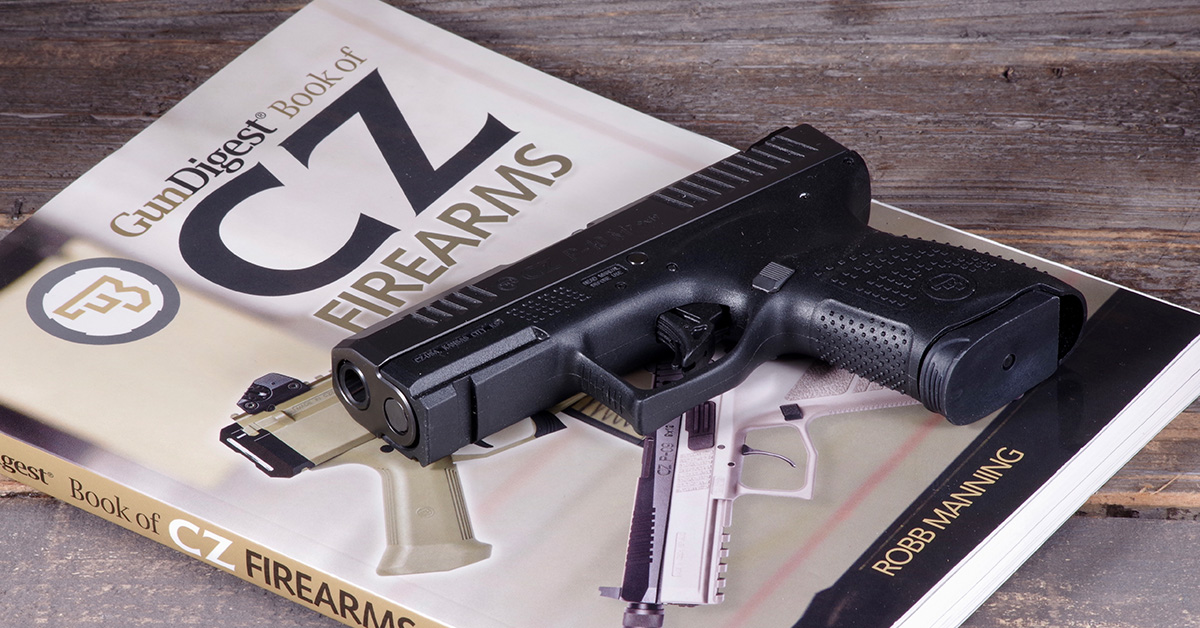
The trigger pull on the test sample was a little heavy, averaging around 6.1 pounds (using my Timney Trigger tension scale). Once the slack is taken out of the trigger and it hits the wall, there’s still a long 1/8 of an inch of travel until the trigger breaks. It’s not gritty at all. It has a fairly short reset, but it is a bit deceiving — as the trigger is let out there’s an audible “click,” except that’s not the reset. You have to keep letting it out until there’s a second audible “click” to reset the trigger. The trigger on the test sample contrasts with my P-10 C, which is light (4.2 pounds) and short, with a crisp break and short reset.
Disassembly
Field disassembly is simple, and the same procedure as most polymer striker-fired handguns. Double check that it’s unloaded and cleared by removing the magazine and cycling the slide. Then visually and physically inspect to make sure there’s no round in the chamber. Point in a safe direction and pull the trigger to release the striker into the un-cocked position. Using one hand, pull the slide slightly to the rear, no more than 3/16 of an inch, or for the rest of the world, no more than 5mm. If you have a punch or something similar, punch out the disassembly pin from right to left. It comes completely out. If you don’t have any tools, use a corner of the magazine baseplate to press the disassembly pin as far as possible, then pull it out the rest of the way. The left end of the pin has only a slight detent to grasp, which makes it a little tricky to pull out. If you have a thumbnail, use it. If not, you can use the front top edge of the magazine. Once the pin is out, remove the slide from the frame and then remove the recoil assembly and barrel. The dual-spring recoil assembly has only one spring captive. The primary spring is not. Use caution to not launch the rod. Reverse the process to reassemble.
Summary
CZ has a long and storied history of making quality firearms. When it comes to quality, I’ve long considered CZ firearms as second to none with high-end European gun makers. The P-10 M continues that tradition, even as CZ has entered a new era with US production. The snag-free design sets it apart from other micro-compact handguns, and it will find itself a home in many concealed carry holsters.
CZ P-10 M Specifications
- Caliber: 9mm Luger
- Magazine Capacity: 7
- Action Type: semi-auto
- Frame: Polymer
- Sights: 3-dot
- Barrel Length: 3.19 inches
- Overall Length: 6.31 inches
- Width: 1 inch
- Weight: 20.1 oz.
- Accessories: includes two magazines
- MSRP: $505
Did You Know…?
Did you know it is better to pull back and release the slide to chamber a round in a pistol rather than thumbing the slide stop?
There are a couple of reasons for this. The first is taking advantage of muscle memory. Training one way to do something is better than training two ways to do the same thing. When in a gun fight (or in this case, a self-defense situation), if you pull the trigger and hear a “click” for whatever reason, the first course of action is to pull back the slide to clear the stoppage and get a fresh round into the chamber. In most cases, this operation will clear the gun and get it back into the fight. If you train to do this in the event of a stoppage, why not increase muscle memory by doing this to send a fresh round into the chamber when you load the magazine? And if you pull the slide when you load the magazine, why not do the same when doing a mag reload and the slide is locked to the rear? Doing the same thing in each instance creates more muscle memory (habit), and not doing the other thing cuts down on any muscle confusion in a critical situation.
The second reason is that thumbing the slide stop can cause unnecessary wear on the ledge of the stop. When you press the lever, the slide grinds off the ledge as it goes by. Over time, this wear can cause the slide stop to not stop the slide, so instead of locking to the rear after the last round is fired, it goes forward. But when you pull the slide to the rear, the lever spring disengages the lever from the slide and the stop is clear of the slide as it goes forward to chamber a round.
- TESTED: Beretta PMXs 9mm Pistol - July 26, 2024
- The Correct Way to Clean a GLOCK - January 15, 2024
- Concealed Carry Guns: How Important is Ergonomics? - December 11, 2023

